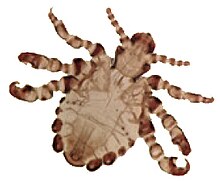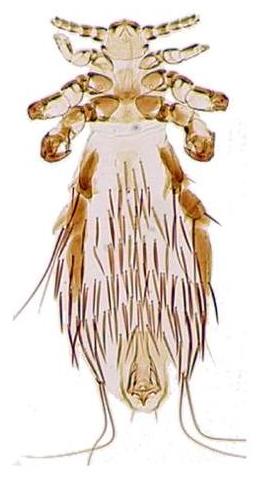
Louse is the common name for any member of the clade Phthiraptera, which contains nearly 5,000 species of wingless parasitic insects. Phthiraptera has variously been recognized as an order, infraorder, or a parvorder, as a result of developments in phylogenetic research.

Sucking lice have around 500 species and represent the smaller of the two traditional superfamilies of lice. As opposed to the paraphyletic chewing lice, which are now divided among three suborders, the sucking lice are monophyletic.

The crab louse or pubic louse is an insect that is an obligate ectoparasite of humans, feeding exclusively on blood. The crab louse usually is found in the person's pubic hair. Although the louse cannot jump, it can also live in other areas of the body that are covered with coarse hair, such as the perianal area, the entire body, and the eyelashes.

Pubic hair is terminal body hair that is found in the genital area and pubic region of adolescent and adult humans. The hair is located on and around the sex organs, and sometimes at the top of the inside of the thighs, even extending down the perineum, and to the anal region. Pubic hair is also found on the scrotum and base of the penile shaft and on the vulva. Around the pubis bone and the mons pubis that covers it, it is known as a pubic patch, which can be styled.
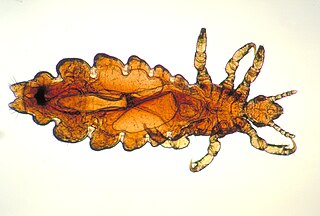
Pediculosis is an infestation of lice from the sub-order Anoplura, family Pediculidae. Accordingly, the infestation with head lice is named pediculosis capitis, while this with body lice, pediculosis corporis. Although pediculosis in humans may properly refer to lice infestation of any part of the body, the term is sometimes used loosely to refer to pediculosis capitis, the infestation of the human head with the specific head louse.
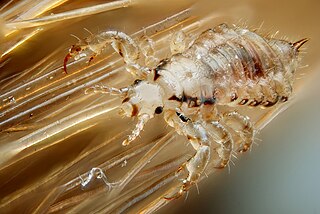
The head louse is an obligate ectoparasite of humans. Head lice are wingless insects that spend their entire lives on the human scalp and feed exclusively on human blood. Humans are the only known hosts of this specific parasite, while chimpanzees and bonobos host a closely related species, Pediculus schaeffi. Other species of lice infest most orders of mammals and all orders of birds.

The mountain gorilla is one of the two subspecies of the eastern gorilla. It is listed as endangered by the IUCN as of 2018.

The Bwindi Impenetrable National Park is a national park in southwestern Uganda. It is part of the Bwindi Impenetrable Forest and is situated along the Democratic Republic of the Congo border next to the Virunga National Park and on the edge of the Albertine Rift. Composed of 321 km2 (124 sq mi) of both lowland and montane forest, it is accessible only on foot. It is a United Nations Educational, Scientific and Cultural Organization-designated World Heritage Site.
A bird louse is any chewing louse of order Phthiraptera which parasitizes warm-blooded animals, especially birds. Bird lice may feed on feathers, skin, or blood. They have no wings, and their biting mouth parts distinguish them from true lice, which suck blood.

The wildlife of Uganda is composed of its flora and fauna. Uganda has a wide variety of different habitats, including mountains, hills, tropical rainforest, woodland, freshwater lakes, swamps and savanna with scattered clumps of trees. The country has a biodiverse flora and fauna reflecting this range of habitats and is known for its primates, including gorillas and chimpanzees. There are ten national parks and thirteen wildlife reserves; some 345 species of mammal and 1020 species of bird have been recorded in the country.

Forensic entomology has three sub-fields: urban, stored product and medico-criminal entomologies. This article focuses on medico-criminal entomology and how DNA is analyzed with various blood-feeding insects.

Tourism in Uganda is focused on Uganda's landscape and wildlife. It is a major driver of employment, investment and foreign exchange, contributing USh 4.9 trillion to Uganda's GDP in the financial year 2012–2013.

Head lice infestation, also known as pediculosis capitis, is the infection of the head hair and scalp by the head louse. Itching from lice bites is common. During a person's first infection, the itch may not develop for up to six weeks. If a person is infected again, symptoms may begin much more quickly. The itch may cause problems with sleeping. Generally, however, it is not a serious condition. While head lice appear to spread some other diseases in Africa, they do not appear to do so in Europe or North America.

Gladys Kalema-Zikusoka is a Ugandan veterinarian and founder of Conservation Through Public Health, an organisation dedicated to the coexistence of endangered mountain gorillas, other wildlife, humans, and livestock in Africa.

Pediculosis pubis is an infestation by the pubic louse, Pthirus pubis, a wingless insect which feeds on blood and lays its eggs (nits) on mainly pubic hair. Less commonly, hair near the anus, armpit, beard, eyebrows, moustache, and eyelashes may be involved. It is usually acquired during sex, but can be spread via bedding, clothing and towels, and is more common in crowded conditions where there is close contact between people.
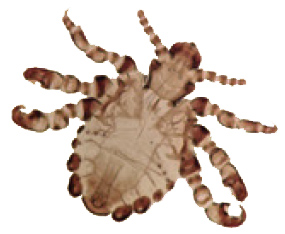
Pthirus is a genus of lice. There are only two extant species, and they are the sole known members of the family Pthiridae. Pthirus gorillae infests gorillas, and Pthirus pubis afflicts humans, and is commonly known as the crab louse or pubic louse. The two species diverged some 3.3 million years ago.

The Bwindi Impenetrable Forest is a large primeval forest located in south-western Uganda and is located in three districts of Kisoro, Kabale and Kanungu. The Bwindi forest is on the edge of the Albertine Rift, the western branch of the East African Rift, at elevations ranging from 1,160 to 2,607 metres. The forest contains around 160 species of trees and over 100 species of ferns. Bwindi Impenetrable Forest Reserve was set up in 1942 on the rim of the Rift Valley.
Lemurpediculus robbinsi is an ectoparasite of Crossley's dwarf lemur, Cheirogaleus crossleyi A. Grandidier, in Madagascar. Both sexes of the louse species are distinct from the two previously known species of Lemurpediculus, L. verruculosus (Ward) and L. petterorum Paulian.
Colpocephalum californici, the California condor louse, is an extinct species of chewing louse which parasitized the California condor. In an example of coextinction, it became extinct when the remaining, Critically Endangered California condors were deloused and treated with pesticides during a captive breeding program.
Nakedness and clothing use are characteristics of humans related by evolutionary and social prehistory. The major loss of body hair distinguishes humans from other primates. Current evidence indicates that anatomically modern humans were naked in prehistory for at least 90,000 years before they invented clothing. Today, isolated Indigenous peoples in tropical climates continue to be without clothing in many everyday activities.
